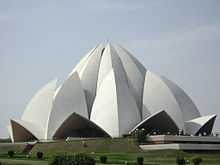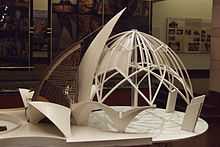Lotus Temple
| Lotus Temple Bahá'í House of Worship | |
|---|---|
 Lotus Temple, illuminated after dark | |
 Location within Delhi
| |
| General information | |
| Type | House of Worship |
| Architectural style | Expressionist |
| Location | New Delhi, India |
| Coordinates | 28°33′12″N 77°15′31″E / 28.553325°N 77.258600°ECoordinates: 28°33′12″N 77°15′31″E / 28.553325°N 77.258600°E |
| Completed | 13 November 1986 |
| Opening | 24 December 1986 |
| Height | 34.27m |
| Technical details | |
| Structural system | Concrete frame and precast concrete ribbed roof |
| Diameter | 70m |
| Design and construction | |
| Architect | Fariborz Sahba |
| Structural engineer | Flint & Neill |
| Other information | |
| Seating capacity | 1,300 |
The Lotus Temple, located in New Delhi, India, is a Bahá'í House of Worship completed in 1986. Notable for its flowerlike shape, it serves as the Mother Temple of the Indian subcontinent and has become a prominent attraction in the city. The Lotus Temple has won numerous architectural awards and been featured in hundreds of newspaper and magazine articles.[1]
Worship
Like all other Bahá'í Houses of Worship, the Lotus Temple is open to all regardless of religion, or any other distinction, as emphasized in Bahá'í texts. The Bahá'í laws emphasize that the spirit of the House of Worship be that it is a gathering place where people of all religions may worship God without denominational restrictions.[2] The Bahá'í laws also stipulate that only the holy scriptures of the Bahá'í Faith and other religions can be read or chanted inside in any language; while readings and prayers can be set to music by choirs, no musical instruments can be played inside. Furthermore no sermons can be delivered, and there can be no ritualistic ceremonies practiced.[2]
Structure

 Visitors approaching the Lotus Temple Bahá'í House of Worship  Interior view .JPG) Interior view of the symbol of the Greatest Name, set at the top of the temple  Lotus Temple at sunset  View of the Bahá'í House of Worship at night |
All Bahá'í Houses of Worship, including the Lotus Temple, share certain architectural elements, some of which are specified by Bahá'í scripture. `Abdu'l-Bahá, the son of the founder of the religion, stipulated that an essential architectural character of a House of Worship is a nine-sided circular shape.[3] While all current Bahá'í Houses of Worship have a dome, this is not regarded as an essential part of their architecture.[4] Bahá'í scripture also states that no pictures, statues or images be displayed within the House of Worship and no pulpits or altars be incorporated as an architectural feature (readers may stand behind simple portable lecture stands).[2]

Inspired by the lotus flower, the design for the House of Worship in New Delhi is composed of 27 free-standing marble clad "petals" arranged in clusters of three to form nine sides.[5] The nine doors of the Lotus Temple open onto a central hall slightly more than 40 meters tall[6] that is capable of holding up to 2,500 people. The surface of the House of Worship is made of white marble from Penteli mountain in Greece, the very same from which many ancient monuments and other Bahá'í Houses of Worship are built.[7] Along with its nine surrounding ponds and the gardens, the Lotus Temple property comprises 26 acres (105,000 m²; 10.5 ha).
The site is in the village of Bahapur, in the National Capital Territory of Delhi. The architect was an Iranian, who now lives in Canada, named Fariborz Sahba. He was approached in 1976 to design it and later oversaw its construction. The structural design was undertaken by the UK firm Flint and Neill. The major part of the funds needed to buy this land was donated by Ardishír Rustampúr of Hyderabad, Sindh, who gave his entire life savings for this purpose in 1953.[8] A portion of construction budget was saved and used to build a greenhouse to study indigenous plants and flowers that would be appropriate for use on the site.[9]
Tourism
Since its inauguration to public worship in December 1986, the Bahá'í House of Worship in Delhi has, as of late 2002, attracted more than 50 million visitors, making it one of the most visited buildings in the world.[10] Its numbers of visitors during those years surpassed those of the Eiffel Tower and the Taj Mahal. On Hindu celebrative days and holy days, it has drawn as many as 150,000 people.
This House of Worship is generally referred to as the "Lotus Temple". In India, during the Hindu festival Durga Puja, several times a replica of the Lotus Temple has been made as a pandal, a temporary structure set up to venerate the goddess Durga.[11] In Sikkim a permanent replica is of the Hindu Legship Mandir, dedicated to Shiva.[12]

Distinctions
The Temple has received wide range of attention in professional architectural, fine art, religious, governmental, and other venues.
Awards
- 1987, the architect of the Bahá'í House of Worship, Mr. Fariborz Sahba, was presented the award for excellence in religious art and architecture by the UK-based Institution of Structural Engineers for producing a building "so emulating the beauty of a flower and so striking in its visual impact".[13]
- 1987, the Interfaith Forum on Religion, Art and Architecture, Affiliate of the American Institute of Architects, Washington, D.C., gave their First Honour award for "Excellence in Religious Art and Architecture" 1987 to Mr. F. Sahba for the design of the Bahá'í House of Worship near New Delhi.[1]
- 1988, the Illuminating Engineering Society of North America conferred the Paul Waterbury Outdoor Lighting Design Award - Special Citation for Exterior Lighting[1]
- 1989, the Temple received an award from the Maharashtra-India Chapter of the American Concrete Institute for "excellence in a concrete structure".[1]
- 1994 edition of Encyclopaedia Britannica, in its 'Architecture' section gives recognition to the Temple as an outstanding achievement of the time.[1]
- 2000, Architectural Society of China as one of 100 canonical works of the 20th century in the recently published "World Architecture 1900-2000: A Critical Mosaic, Volume Eight, South Asia".[14]
- 2000, GlobArt Academy, based in Vienna, Austria, presented its "GlobArt Academy 2000" award to the architect of the Lotus Temple, Fariborz Sahba, for "the magnitude of the service of [this] Taj Mahal of the 20th century in promoting the unity and harmony of people of all nations, religions and social strata, to an extent unsurpassed by any other architectural monument worldwide."[14]
Publications
 Gardens at the Bahá í House of Worship  Surrounding area  Information centre at the Bahá'í House of Worship  Some of the displays at the entrance of the information centre |
Articles
As of 2003, it had been featured in television programmes in India, Russia, and China. The Baha'i World Centre Library has archived more than 500 publications which have carried information on the Temple in the form of articles, interviews with the Architect and write-ups extolling the structure.[1]
- In France, the magazine "Actualite des Religions" published a four-page article on the Lotus Temple in the fall of 2000 in a special edition called "Les religions et leurs chef-d'œuvres" (Religions and Their Masterpieces).[15][1]
- Guinness World Records 2001
- Architecture (magazine) September 1987
- Lighting Design+Application Vol 19, No. 6, Illuminating Engineering Society of North America "Taj Mahal of the Twentieth Century"
- Wallpaper* October 2002
- Progressive Architecture, February[1] and again December 1987
- World Architecture: A Critical Mosaic 1900-2000, Vol 8, by Kenneth Frampton, Springer-Verlog Wien publishers, New York - "A power icon of great beauty ... an import symbol of the city."
- Faith & Form - Journal of the IFRAA affiliate of the American Institute of Architects, Vol XXI "an extraordinary feat of design, construction and appropriateness of expressions"
- Structural Engineer, UK (annual) December 1987
- Encyclopaedia Iranica 1989
Books
- Forever in Bloom: The Lotus of Bahapur, Photographs by Raghu Rai, text by Roger White, Time Books International, 1992
- The Dawning Place of the Remembrance of God, Thomas Press, 2002
Stamps
-
 6.50 postage Stamp featuring Baha'i House of Worship, New Delhi, India[16]
6.50 postage Stamp featuring Baha'i House of Worship, New Delhi, India[16]
Music
- Temple Dedication service (1986).[17]
- Jewel in the Lotus (album) produced in 1987 by the keyboardist Jack Lenz for Don't Blink Music, Inc., in Ontario, Canada with songs or voices by Seals & Crofts, Layli Ericks, and others.[18]
Most visitors
- "The most visited building in the world, according to a CNN report" [19]
- "The most visited building in India, surpassing even the Taj Mahal with some 4.5 million visitors a year."[20]
- "The most visited religious building in the world" Guinness World Records, 2001
Notable visitors
- Pandit Ravi Shankar sitar maestro
- Ambassadors of Tanzania, Hungary, Panama
- Officers of Government (Ministers, Premiers) from Bermuda, Hungary, India, Ivory Coast, Nepal, USSR/Russia, Romania, Singapore, Tajikstan, Yemen, Yugoslavia, Zambia
- Members of the Supreme Court of India
- Prince Niranjan Shah, of Nepal
- Dr. Uton Muchtar Rafei, Regional Director, World Health Organization
- The President of Iceland, Ólafur Ragnar Grímsson was the first Head of State on an official state visit[21]
- First Lady of the Slovak Republic, Silvia Gasparovicova
- Sathya Sai Baba in April 2010[22]
- 1998 article with short list of notable visitors[23]
- 2003 list of notable visitors [1]
- 2004 addition [24]
See also
- Bahá'í Faith in India
- Sydney Opera House - a modern structure with a similar design
- Auditorio de Tenerife – a modern structure with a similar design
- Palau de les Arts Reina Sofia – a modern structure with a similar design
Notes
- ↑ 1.0 1.1 1.2 1.3 1.4 1.5 1.6 1.7 1.8 Bahá'í Houses of Worship, India The Lotus of Bahapur
- ↑ 2.0 2.1 2.2 Rafati, V.; Sahba, F. (1989). "Bahai temples". Encyclopædia Iranica.
- ↑ `Abdu'l-Bahá (1982) [1912]. The Promulgation of Universal Peace (Hardcover ed.). Wilmette, Illinois, USA: Bahá'í Publishing Trust. p. 71. ISBN 0-87743-172-8.
- ↑ Shoghi Effendi to an individual believer, Lights of Divine Guidance (volume 1), pg 311
- ↑ Architecture of the Bahá'í House of Worship
- ↑ "Bahá'í Houses of Worship". Bahá'í International Community. 2006. Retrieved 2008-03-09.
- ↑ "Penteli marbles for Bahai temples". Dionyssos Marbles. 2010.
- ↑ Faizi, Gloria (1993). Stories about Bahá'í Funds. New Delhi, India: Bahá'í Publishing Trust. ISBN 81-85091-76-5.
- ↑ "["Gardens of Worship"]". ["Recreating Eden"]. Season 03. Episode 30. 2006.
- ↑ Baha'i Community of Canada
- ↑ Chakraborty, Debarati. "Newsline 28 September 2006: Here's Delhi's Lotus Temple for you at Singhi Park!". Retrieved 2007-05-29.
- ↑ Satellite image in Wikimapia.
- ↑ An Architectural Marvel Published in The Tribune, Chandigarh, by Anil Sarwal.
- ↑ 14.0 14.1 Baha'i Temple in India continues to receive awards and recognitions New Delhi, 5 December 2000 (BWNS)
- ↑ Architect's Website(enter->publications)
- ↑ Baha'i Stamps
- ↑ Baha'i Prayers and Songs
- ↑ Jewel in the Lotus
- ↑ http://transcripts.cnn.com/TRANSCRIPTS/0107/14/i_hs.00.html
- ↑ Commemorations in Chicago highlight the immense impact of House of Worship OneCountry, Volume 15, Issue 1 / April–June 2003
- ↑ President of Iceland visits Baha'i Temple in New Delhi
- ↑ Sri Sathya Sai Baba's trip to Delhi and Shimla 2010
- ↑ An Architectural Marvel by Prof. Anil Sarwal, First published in The Tribune, Chandigarh
- ↑ Distinguished visitors praise Baha'i Temple
External links
| Wikimedia Commons has media related to Lotus Temple. |
- Official Website
- Lotus Temple - thedivineindia.com
- Delhi Gallery : Lotus Temple
- Major Bahai Temples Around The World with Photos
| |||||||||||||||||||
| ||||||||||||||||||||
